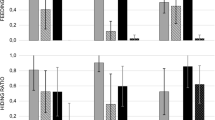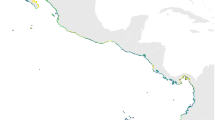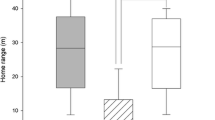Abstract
The exotic Asian shore crab, Hemigrapsus sanguineus, was recently introduced to the northeastern coast of North America and during the 1990's breeding populations were established throughout southern New England. In 1997–1998, ecological studies of several co-occurring brachyuran crabs were conducted and in native (Tanabe Bay, Japan) and invaded (Long Island Sound, USA) habitats of H. sanguineus. Standardized comparisons of H. sanguineus were made between the 2 habitats using data on crab sizes, utilization of space, and food habits. Results revealed that (1) the resource use of H. sanguineus was quite different from that of other resident species in its invaded habitat, and (2) there were no substantial changes in resource utilization by H. sanguineus after it became established in the invaded habitat (relative to native Tanabe Bay). Differing patterns of resource use by H. sanguineus and other crabs in the invaded habitat, the lack of restriction in resource use by H. sanguineus following its introduction, and the climatological and physical similarities between native and invaded regions likely contributed to the successful invasion of H. sanguineus into rocky intertidal habitats in southern New England.
Similar content being viewed by others
References
Anderson DT (1994) Barnacles. Structure, Function, Development, and Evolution. Chapman & Hall, London, 357 pp
Batie RE (1983) Rhythmic locomotor activity in the intertidal shorecrab Hemigrapsus oregonensis (Brachyura, Grapsidae) from the Oregon Coast. Northwest Science 57(1): 49-56
Beck MW (1995) Size-specific shelter limitation in stone crabs: a test of the demographic bottleneck hypothesis. Ecology 76(3): 968-980
Berrill M (1982) The life cycle of the green crab Carcinus maenas at the northern end of its range. Journal of Crustacean Biology 2(1): 31-39
Carlton JT (1993) A steady stream of invading organisms creates ecological roulette in New England waters. Estuarine Research Federation Newsletter 19(4): 11
Carlton JT (1995) Forward. In: Balcom N (ed) Proceedings of the Northwest Conference on Non-Indigenous Aquatic Nuisance Species. Connecticut Sea Grant College Program, Groton, Connecticut
Carlton JT (1996) Pattern, process, and prediction in marine invasion ecology. Biological Conservation 78: 97-106
Case TJ (1990) Invasion resistance arises in strongly interacting species-rich model competition communities. Proceedings of the National Academy of Sciences, USA 87: 9610-9614
Cohen AN, Carlton JT and Fountain MC (1995) Introduction, dispersal, and potential impacts of the green crab Carcinus maenas in San Francisco Bay, California. Marine Biology 122: 225-237
Colwell RK and Futuyma DJ (1971) On the measurement of niche breadth and overlap. Ecology 52: 567-576
Depledge MH (1984) Cardiac activity in the intertidal crab Hemigrapsus sanguineus (de Haan). Asian Marine Biology 1: 115-123
Drake JA, Mooney HA, Di Castri F, Groves RH, Kruger M, Rejmanek M and Williamson M (1989) Biological Invasions: A Global Perspective. John Wiley and Sons, New York
Eggleston DB (1990) Functional responses of blue crabs Callinectes sapidus Rathbun feeding on juvenile oysters Crassostrea virginica (Gmelin): effects of predator sex and size, and prey size. Journal of Experimental Marine Biology and Ecology 143: 73-90
Eggleston DB, Lipcius RN, Miller DL and Coba-Cetina L (1990) Shelter scaling regulates survival of juvenile Caribbean spiny lobster Panulirus argus. Marine Ecology Progress Series 62: 79-88
Ehrlich PR (1986) Which animal will invade? In: Mooney HA and Drake JA (eds) Ecology of Biological Invasions of North America and Hawaii, pp 79-85. Springer, New York
Ehrlich PR (1989) Attributes of invaders and the invading process: vertebrates. In: Drake JA, Mooney HA, Di Castri F, Groves RH, Kruger M, Rejmánek M and Williamson M (eds) Biological Invasions: A Global Perspective, pp 315-328. John Wiley and Sons, New York
Elner RW (1981) Diet of green crab Carcinus maenas (L.) from Port Hebert, southwestern Nova Scotia. Journal of Shellfish Research 1(1): 89-94
Elner RW and Hughes RN (1978) Energy maximization in the diet of the shore crab, Carcinus maenas. Journal of Animal Ecology 47: 103-116
Elton CS (1958) The Ecology of Invasions by Animals and Plants. Methuen, London, 181 pp
Fernandez M, Iribarne O and Armstrong D (1993) Habitat selection by young-of-the-year Dungeness crab Cancer magister and predation risk in intertidal habitats. Marine Ecology Progress Series 92(1–2): 171-177
Fukui Y (1988) Comparative studies on the life history of the grapsid crabs (Crustacea, Brachyura) inhabiting intertidal cobble and boulder shores. Publication of the Seto Marine Biological Laboratory 33(4–6): 121-162
Fukui Y and Wada K (1983) Intertidal anomura and brachyura and their distributions on the south coast of Tanabe Bay. The Nanki Biological Society 25(2): 159-167
Gerard VA, Cerrato RM and Larson AA (1999) Potential impacts of a Western Pacific grapsid crab on intertidal communities of the northwestern Atlantic Ocean. Biological Invasions 1: 353-361
Grosholz ED and Ruiz GM (1996) Predicting the impact of introduced marine species: lessons from the multiple invasions of the European green crab Carcinus maenus. Biological Conservation 78: 59-66.
Hengefeld R (1989) Dynamic of Biological Invasions. Chapman & Hall, London
Hines AH (1982) Coexistence in a kelp forest: size, population dynamics, and resource partitioning in a guild of spider crabs (Brachyura, Majidae). Ecological Monographs 52(2): 179-198
Hobbs RJ (1989) The nature and effect of disturbance relative to invasions. In: Drake JA, Mooney HA, Di Castri F, Groves RH, Kruger M, Rejmánek M and Williamson M (eds) Biological Invasions: A Global Perspective, pp 389-405. John Wiley and Sons, New York
Hulbert SH (1978) The measurement of niche overlap and some relatives. Ecology 59: 67-77
Hutchinson GE (1957) Concluding remarks. In: Cold Spring Harbor Symposium on Quantitative Biology 22: 415-427
Kikuchi T, Tanaka M, Nojima S and Takahashi T (1981) Ecological studies on the pebble crab, Gaetice depressus (de Haan). I. Ecological distribution of the crab and environmental conditions. Publication from the Amakusa Marine Biological Laboratory 6(1): 23-34
Lafferty KD and Kuris AM (1996) Biological control of marine pests. Ecology 77(7): 1989-2000
Lee SY and Seed R (1992) Ecological implications of cheliped size in crabs: some data from Carcinus maenas and Liocarcinus holsatus. Marine Ecology Progress Series 84: 151-160
Levins R (1968) Evolution in changing environments. In: Monographs in Population Ecology. Volume 2. Princeton University Press, Princeton, New Jersey
Lindberg WJ (1980) Behavior of the Oregon mud crab, Hemigrapsus oregonensis (Dana) (Brachyura, Grapsidae). Crustaceana 39(3): 262-280
Lohrer AM (2000) Mechanisms and consequences of an exotic crab species invasion. Doctoral Dissertation, University of Connecticut, Storrs, Connecticut, 147 pp
Lohrer AM and Whitlatch RB (1997) Ecological studies on the recently introduced Japanese shore crab (Hemigrapsus sanguineus), in eastern Long Island Sound. In: Balcom NC (ed) Proceedings of the Second Northeast Conference on Nonindigenous Aquatic Nuisance Species, pp 49-60. Connecticut Sea Grant College Program, Groton, Connecticut
Lohrer AM, Fukui Y, Wada K and Whitlatch RB (2000) Structural complexity and vertical zonation of intertidal crabs, with focus on the habitat requirements of the invasive Asian shore crab, Hemigrapsus sanguineus (de Haan). Journal of Experimental Marine Biology and Ecology 244: 203-217
Lützen J and Takahashi T (1997) Sacculina polygenea, a new species of rhizocephalan (Cirrepedia: Rhizocephala) from Japan, parasitic on the intertidal crab Hemigrapsus sanguineus (De Haan, 1835) (Decapoda: Brachyura: Grapsidae). Crustacean Research 26: 103-108
McDermott JJ (1991) A breeding population of the Western Pacific crab Hemigrapsus sanguineus (Crustacea: Decapoda: Grapsidae) established on the Atlantic coast of North America. Biological Bulletin 181: 195-198
McDermott JJ (1992) Biology of the Western Pacific crab, Hemigrapsus sanguineus, living along the mid-Atlantic coast of the United States. American Zoologist 32(5): 73A
McDermott JJ (1998a) The western Pacific brachyuran Hemigrapsus sanguineus (Grapsidae) in its new habitat along the Altlantic coast of the Untied States: reproduction. Journal of Crustacean Biology 18(2): 308-316
McDermott JJ (1998b) The western Pacific brachyuran Hemigrapsus sanguineus (Grapsidae) in its new habitat along the Altlantic coast of the Untied States: geographic distribution and ecology. ICES Journal of Marine Science 55(2): 289-298
Moksnes P-O, Pihl L and van Montfrans J (1998) Predation on postlarvae and juveniles of the shorecrab Carcinus maenas: importance of shelter, size, and cannibalism. Marine Ecology Progress Series 166: 211-225
O'Connor RJ (1986) Biological characteristics of invaders among bird species in Britain. Philosophical Transactions of the Royal Society of London B, Biological Sciences 314: 583-598
Ohgaki S, Yamanishi R, Nabeshima Y and Wada K (1997) Distribution of intertidal macrobenthos in 1993 around Hatakejima Island, central Japan, compared with 1969 and 1983–84. Benthos Research 52(2): 89-102
Petraitis PS (1979) Likelihood measures of niche breadth and overlap. Ecology 60: 703-710
Pillay KK and Ono Y (1978) The breeding cycles of 2 species of grapsid crabs (Crustacea: Decapoda) from the North Coast of Kyushu, Japan. Marine Biology 45(3): 237-248
Reise K (1985) Tidal Flat Ecology. Springer-Verlag, Berlin, Germany
Rejmánek M and Richardson, DM (1996) What attributes make some plant species more invasive? Ecology 77(6): 1661-1666
Robinson JV and Dickerson JE (1987) Does invasion sequence affect community structure? Ecology 68(3): 587-595
Ropes JW (1968) The feeding habits of the green crab, Carcinus maenas (L). US Fish and Wildlife Service, Fisheries Bulletin 67: 183-203
Ropes JW (1989) The food habits of five crab species at Pettaquamscutt River, Rhode Island. US National Marine Fisheries Service, Fisheries Bulletin 87(1): 197-204
Saigusa M and Kawagoye O (1997) Circatidal rhythm of an intertidal crab, Hemigrapsus sanguineus: synchrony with unequal tide height and involvement of a light response mechanism. Marine Biology 129: 87-96
Sakai T (1976) Crabs of Japan and the Adjacent Seas. Kodansha, Tokyo
Say T (1817) An account of the Crustacea of the United States. Journal of the Academy of Natural Sciences of Philadelphia 1: 57-63
Schoener TW (1974) Some methods for calculating competition coefficients from resource-utilization spectra. American Naturalist 108: 332-340
Stachowicz JJ, Whitlatch RB and Osman RW (1999) Species diversity and invasion resistance in a marine ecosystem. Science 286: 1577-1579
Suarez AV, Tsutsui ND, Holway DA and Case TJ (1999) Behavioral and genetic differentiation between native and introduced populations of the Argentine ant. Biological Invasions 1: 43-53
Takada Y and Kikuchi T (1991) Seasonal and vertical variation of the boulder shore fauna in Amakusa. Publication from the Amakusa Marine Biological Laboratory 11(1): 1-17
Takahashi T and Matsuura S (1994) Laboratory studies on molting and growth of the shore crab, Hemigrapsus sanguineus de Haan, parasitized by a Rhizocephalan barnacle. Biological Bulletin 186: 300-306
Takahashi K, Miyamoto T, Mizutori Y and Ito M (1985) Ecological studies on rocky shore crabs in Oshoro Bay. Scientific Reports of the Hokkaido Fisheries Experimental Station 27: 71-89 [in Japanese with English abstract]
Takahashi T, Iwashige A and Matsuura S (1997) Behavioral manipulation of the shore crab, Hemigrapsus sanguineus, by the rhizocephalan barnacle, Sacculina polygenea. Crustacean Research 26: 153-161
Tilman (D) (1997) Community invasibility, recruitment limitation, and grassland biodiversity. Ecology 78: 81-92
Vigh DA and Fingerman M (1985) Molt staging in the fiddler crab Uca pugilator. Journal of Crustacean Biology 5(3): 386-396
Warman CG, Reid DG and Naylor E (1993) Variation in the tidal migratory behaviour and rhythmic light reponsiveness in the shore crab, Carcinus maenas. Journal of the Marine Biological Association of the United Kingdom 73: 355-364
Weiss HM (1995) Marine animals of southern New England and New York. State Geological and Natural History Survey of Connecticut. Department of Environmental Protection Publications
Willason W (1981) Factors influencing the distribution and coexistence of Pachygrapsus crassipes and Hemigrapsus oregonensis (Decapoda: Grapsidae) in a California Salt Marsh. Marine Biology 64: 125-133
Williams AB (1984) Shrimps, Lobsters, and Crabs of the Atlantic Coast of the Eastern United States, Maine to Florida. Smithsonian Institution Press, Washington, DC
Williams AB and McDermott JJ (1990) An eastern United States record for the Western Indo-Pacific crab, Hemigrapsus sanguineus (Crustacea: Decapoda: Grapsidae). Proceedings of the Biological Society of Washington 103(1): 108-109
Williamson M (1996) Biological Invasions. Chapman & Hall, London, 244 pp
Williamson M and Fitter A (1996) The characteristics of successful invaders. Biological Conservation 78: 163-170
Wiser SK, Allen RB, Clinton PW and Platt KH (1998) Community structure and forest invasion by an exotic herb over 23 years. Ecology 79(6): 2071-2081
Rights and permissions
About this article
Cite this article
Lohrer, A.M., Whitlatch, R.B., Wada, K. et al. Home and Away: Comparisons of Resource Utilization by a Marine Species in Native and Invaded Habitats. Biological Invasions 2, 41–57 (2000). https://doi.org/10.1023/A:1010069327402
Issue Date:
DOI: https://doi.org/10.1023/A:1010069327402




